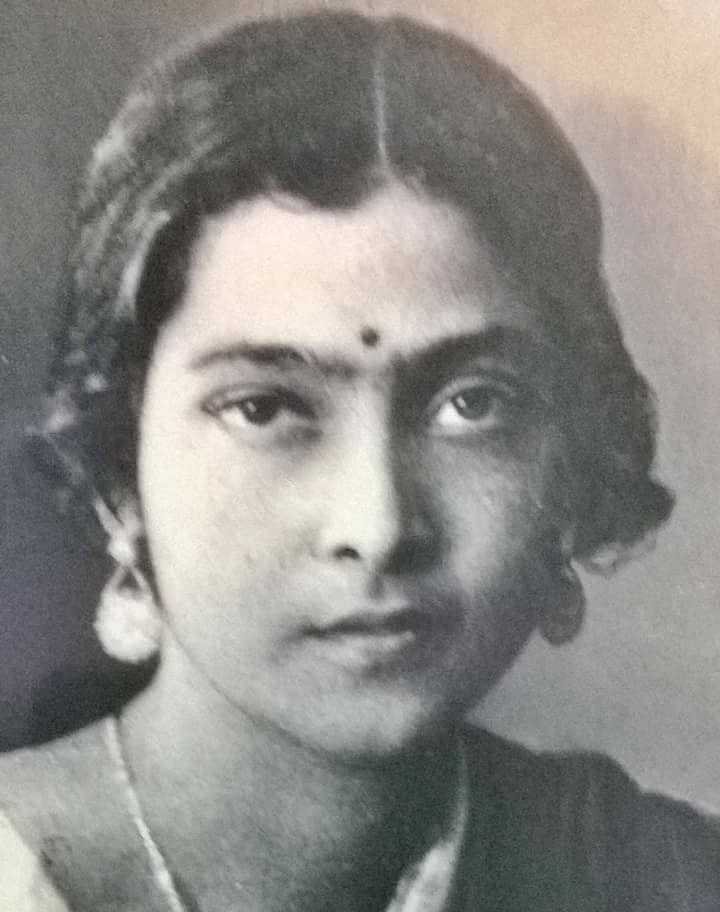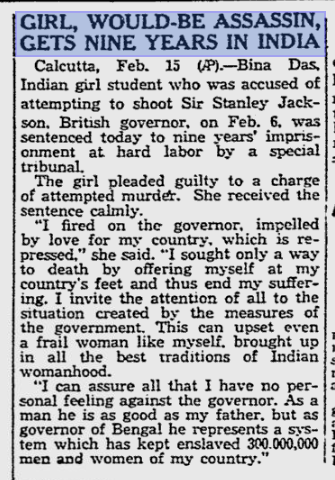At 21, This Feisty Bengali Woman Etched Her Mark on India’s Freedom Struggle!
She was no trained assassin, but the 21-year-old aimed five shots at the then Bengal Governor Stanley Jackson known as ‘Jackers.'

To honour this nation’s Independence Day, we bring you the fascinating stories of #ForgottenHeroes of #IndianIndependence that were lost among the pages of history.
She was only 21 when Bina Das created history by becoming one of the first women to hold up arms against the British Raj.
She was no trained assassin, but the 21-year-old aimed five shots at the then Bengal Governor Stanley Jackson known as ‘Jackers’, who was held in high respect since he also served as captain of the All-England cricket team.
The brave woman who put her neck on the line to assert rebellion against the Raj with the daring move became an inspiration to several young women to join the freedom movement.
Unfortunately, she remained one among the many lionhearted women freedom fighters lost in the pages of history, who were never really paid their dues.
Who was Bina Das?

Bina was born to the renowned Brahmo teacher, Beni Madhab Das, and his wife, social worker Sarala Devi. Even her older sister, Kalyani Das, was a freedom fighter.
Das completed her schooling from St John’s Diocesan Girls’ Higher Secondary School and joined the Chhatri Sangha (Women Students Association) established in 1928.
It was a group of 100 members from Brahmo Girl’s School, Victoria School, Bethune College, Diocesan College and Scottish Church College, operational in Calcutta, which trained and recruited future revolutionaries. They arranged study circles where these young women learned everything from lathi and swordplay to cycling and motor driving.
Many of them left their homes and settled in a hostel established by Bina and Kalyani’s mother, called the Punya Ashram. Bombs were hidden at this hostel to evade police checks. Revolutionary Kamala Das Gupta who also happened to have supplied the revolver used by Bina to fire at the governor, would carry bombs in small leather and tin cases to dispatch it to other members.
On February 6, 1932, Bina Das walked into the Calcutta University where the then Governor, Stanley Jackson was delivering the convocation speech. Little did anyone know, the timid-looking girl had a revolver concealed under her gown.
Just as the Governor was addressing the crowd, Bina got up from her seat, fished out the revolver and opened fire at him. He dodged the first two shots. The Vice-Chancellor, Hassan Suhrawardy, quickly leapt into action to shield the governor.
Even as Suhrawardy was trying to overpower a young Bina, she did not stop firing. She fired three more shots until she exhausted her ammunition. One bullet whipped past the Governor’s ear, but he escaped unscathed. In the process though, a senior professor, Dr Dineshchandra Sen was injured.
Bina was all over the newspapers, making headlines as the ‘Calcutta graduate student who attempted to kill the Governor’.

She was arrested and sentenced to nine years of rigorous imprisonment. But even as she was pressured to confess the names of her accomplices during interrogation, she refused to spill the beans.
“The Governor of Bengal represents a system which enslaved three hundred million of my countrymen and experienced country-women.” She added how she aimed to create a crack in the structure of the British rule by opening fire on the Governor–a symbol of its authority and power

.In a statement before the tribunal of the Calcutta High Court, she said,
“I confess that I fired at the Governor on the last Convocation Day at the Senate House. I hold myself entirely responsible for it. My object was to die, and if I had to die, I wanted to do it nobly, fighting against this despotic system of government which has kept my country in perpetual subjection to its infinite shame and endless sufferings, and all the while fighting in a way which cannot but tell. I fired at the Governor impelled by my love for my country which is being repressed and what I attempted to do for the sake of my country was a great violence on my own nature too.”
In her memoir, Jeeban Adhyayan, her sister Kalyani Das, talks about how destiny helped the sisters cross paths when they were detained in the same jail, then known as the Hijli Detention Camp. This was later transformed into a museum and is now the place where the prestigious IIT-Kharagpur stands.
According to a review of this memoir penned by Makarand Paranjape, with her companions, Bina would test their pain-bearing capacity by staging hunger strikes. “She would stick her feet into a nest of poisonous ants or her fingers into the flame, thus literally playing with fire,” he writes.
But despite the atrocities and the humiliation that came her way, Bina never stopped fighting for freedom. After her release from prison, she participated in the Quit India Movement led by Mahatma Gandhi and also joined the revolutionary club – Jugantar. She spent another three years in prison when she held the post of the secretary of the Calcutta Congress Committee.
She married her fellow freedom fighter Jyotish Bhowmick in 1947 but did not stop her activism until independence.
After her husband’s death, she left Calcutta to settle in an ashram in Rishikesh, away from the public eye. It was said that she had taken up a teaching job to meet ends after that. Even in her final years, she refused to accept the pension for freedom fighters by the government.
Read more: Lost Her Husband to British Lathi Charge. Yet This Young Girl Kept the Tricolour Flying!
Her end was particularly unfortunate. Veteran freedom fighter, Prof Satyavrata Ghosh, in an article titled, Flash Back: Bina Das – Reborn, writes about her poignant death.
He says, “She ended her life by the roadside. The dead body was in a partially decomposed state. It was found by the passing crowd. The police were informed, and it took them a month to determine her identity. It was in independent India for which the once-acclaimed Agni Kanya had staked her everything. Now lay her dead body there unknown, unwept and unsung. The nation should remember this somewhat poignant story, even though late and salute her, the great lady.”
(Edited by Shruti Singhal)
Like this story? Or have something to share?
Write to us: [email protected]
Connect with us on Facebook and Twitter.
NEW: Click here to get positive news on WhatsApp!
If you found our stories insightful, informative, or even just enjoyable, we invite you to consider making a voluntary payment to support the work we do at The Better India. Your contribution helps us continue producing quality content that educates, inspires, and drives positive change.
Choose one of the payment options below for your contribution-
By paying for the stories you value, you directly contribute to sustaining our efforts focused on making a difference in the world. Together, let’s ensure that impactful stories continue to be told and shared, enriching lives and communities alike.
Thank you for your support. Here are some frequently asked questions you might find helpful to know why you are contributing?


This story made me
-
97
-
121
-
89
-
167













